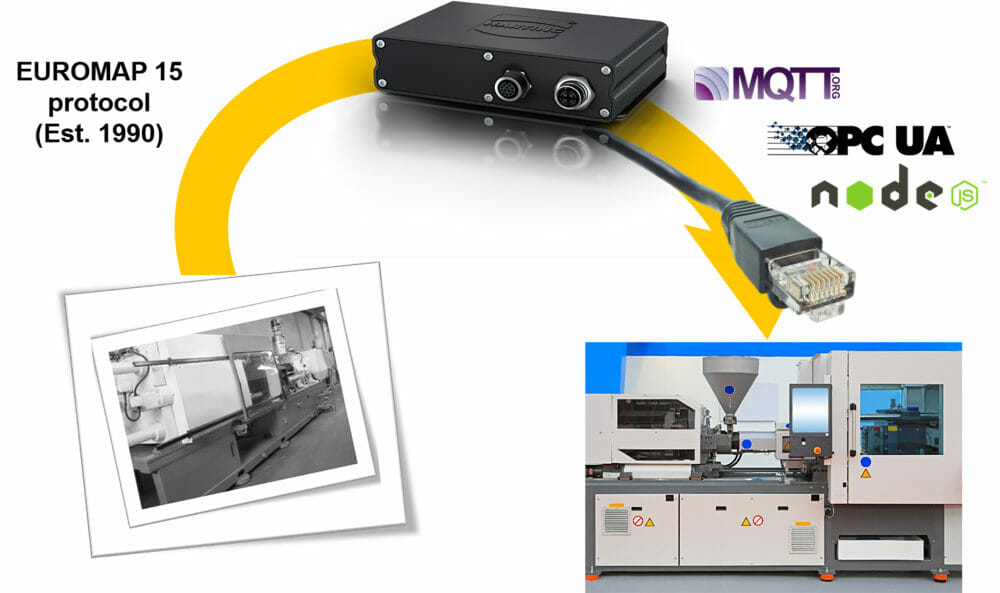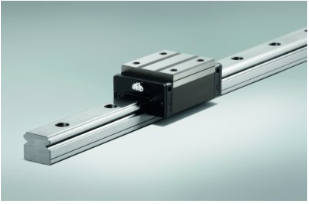Central machine monitoring and process optimisation is the best way to ensure that production lines and their associated constituent part machinery operate more effectively and economically. Many machines in well-established production lines, which may be between 15 and 30 years old, can still perform their main functional tasks successfully, however they do so much less efficiently than their modern day counterparts. For example, they don’t have the same level of computing power, enough memory capacity to record and store the relevant data, or ability to communicate with their modern equivalents. In many cases, these machines also use data formats and protocols from the 80s and 90s, which are no longer used by today’s PLCs and industrial PCs.
A prime example of a machine that might perform one critical function within a typical production line environment might be a plastics injection moulding machine. Such machines when well-maintained can reach as much as a 30-year operational life. However, their main operating software protocol would almost certainly be no longer supported and virtualisation in the MES (Manufacturing Execution System), which is a control system for managing and monitoring work-in-process on a factory floor, would neither be economically sensible nor reliable.
An MES keeps track of all manufacturing information in real time, receiving up-to-the-minute data from robots, machine monitors and employees. Although manufacturing execution systems used to operate as self-contained systems, they are increasingly being integrated with enterprise resource planning (ERP) software suites. The goal of a manufacturing execution system is to improve productivity and reduce cycle-time, the total time to produce an order.
HARTING’s new MICA (Modular Industrial Computing Architecture) edge computing device can directly address the above mentioned issues, upgrading older machines by providing a protocol converting gateway to the central operating software controls of the newer version and at a fraction of the investment cost of such a new machine. This is due to the fact that with MICA’s modular open platform, the HARTING IIC MICA permits the user to choose the programming language and development environment according to what they are more familiar with. It can create a virtual image of a device or a machine in the digital world. It enables modern interfaces for devices whose communications are outdated. This means that you can convert old machine protocols into OPC-UA or MQTT (MQTT is a machine-to-machine (M2M)/”Internet of Things” connectivity protocol), in order to connect legacy machines to IoT or MES systems
MICA fits anywhere. With dimensions of 13 x 8 x 3.5 cm, it is extremely compact and can be fitted directly at the machine or on the DIN rail in the electrical cabinet. MICA is robust, has no fan and is maintenance-free. The system is designed for harsh industrial and railway environments. It can be used in metallic environments and is resistant to dust, moisture and temperature fluctuations (IP67). Remote servicing for the MICA can be performed with a web browser.
MICA has a modular design architecture made from open hardware and software components. Unlike single-board computers – such as the Raspberry Pi – this device is divided into three control boards. A power and network, CPU and an end-user customisable function I/O board. For this function board RFID, WLAN, BLE, SSD storage or fieldbus functionality can be integrated with suitable I/O connectivity, without changing the form factor or degree of protection of the MICA unit.
MICA is easy to use, with the touch-optimised interface for end users and administrators, implemented entirely in HTML5 and JavaScript. It provides an open system software environment that allows developers from both the production and IT worlds to quickly implement projects and customise without any special tools. Applications are executed in their own Linux-based containers which contain all the necessary libraries and drivers. This means that package dependencies and incompatibilities are a thing of the past. In addition, such containers run in individual ‘Sandboxes’ which isolate and secure different applications from each other with their own separate log-in and IP Address. As a result, there should be no concerns over data security when MICA is allowed access to a higher-level production operating network.
MICA is already offered with a number of containers such as Java, Python C/C++, OPC-UA, databases and web toolkits. The modularity and the use of an intermediate JSON format allow other legacy systems to be integrated in the future with minimal effort, only the log-input container is replaced. In addition, other protocols can be easily supported by replacement of a container on the server side, e.g. MQTT
To find out more about HARTING’s MICA and passive RFID technologies please visit www.HARTING.co.uk/mica







